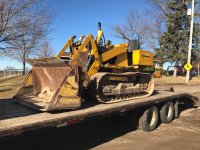If it's like all I've seen, & operated, the should be 3 levers on the center console. 2 tall ones, and one short one. The short one is forward and reverse. The 2 tall ones are separate controls for each track. Full back, low range, forward one notch, neutral, full forward high range. You can do a power turn, by placing one of the tall levers in low, and the other in high. There is also a high and low shift, of the main transmission, using a lever coming up through the floor board. 99.9% of the time, it was operated in the low side, if I remember correctly as back. The only reason it was ever shifted to high, was to tram a long distance, and that was in the low side of the console shifters.
You can also do a soft turn, putting one track in either low, or high, and the other in neutral. Just be really careful using the brakes. They are dry brakes, and after a while of non use, they can grab. Usually fine dirt, and/or rust gets in the brake chambers. If you just touch the brake, it will make the ball in the expander crawl up to the full braking position. And..., also be aware that when you push the brake down part was, it kicks the track out of gear, and it will free wheel, if you don't catch it by pushing it down until the brake catches it.
Seeing it pulled on makes me rather shudder, thinking you'll have a tendency to try and slow it down, with the brakes when backing it off. Do know when you do that, going into a free wheel, and brake catching can turn you sideways on those ramps in a split second. So, when you go to back it off, do it at an idle, in low range. Be straight with the ramps, and let the transmission catch it coming off. Do NOT touch a brake..!! The engine will speed up a bit when it picks up speed backing off, but let it go. Much better than free wheeling... Keep the bucket within a foot of the deck/ramps. Height will changes as you back off, and the back of the tracks get on the ground. You'll need to raise the bucket as you back completely off. Try to keep it within a foot or so, in case it gets away from you. You can always drop the bucket, using it as an emergency brake.
And, if you plan on hauling it much, back it on, and pull it off. You have much more control of the machine.
As for general operation, when shifting from forward to reverse, let the machine come to a stop, before changing direction. It has a torque converter just like in a car, or truck. And you don't shift your truck from forward to reverse, without stopping. Same principle. You may do it several times, but eventually you'll break a motor, or transmission mount. On fairly level ground, just letting off the foot accelerator, it should stop within a matter of a foot, or so.
If the brakes are grabby, you'll need to remove the floor pan, and remove the brake chambers on the side of the transmission. Clean the facing in the chamber, and on the side of the transmission. If you look at the brake parts, you'll see two brake discs, and an expander between them. Separate the expander, and clean the 7/8" ball bearing, expander balls, or replace them If they are pitted. Clean the grooves of rust, and probably compacted dirt. I use a 3" knotted cup brush to clean what I can, then finish with an air die grinder, with a 2" Roloc disc type head, using the medium gasket removal type discs. They polish things up nice, but don't cut it like sanding discs. I've read you're not supposed to, but I put a real thin coat of Never seize in the grooves, and on the expander balls. Makes for a real smooth braking action, until they get grabby again. I'm thinking the "not supposed to" part would be if you slathered it on, and then it got on the brake facings. But, I've never had any problems just putting a this coat on, basically enough to turn things silver, not gob it in there.
Does it have the ROPS mounts on it..?? I'm thinking by it's age, it was built when ROPS cages weren't required. Depending on what you're going to do with it... If your planning on taking out trees, a ROPS, and limb risers could keep a tree off of you. I had a buddy at work get pinned in the seat, when he'd taken the ROPS off to push rip rap in under a small bridge. He took it back to the yard, and they had him push some dirt & small trees, stumps, etc. into a swampy area they were filling. A tree jumped up over the blade, knocked the exhaust pipe off, and pinned him to the back of the seat, pinning both arms, to where he could not back up, until he finally got his one arm free to do that.
Just be really careful, things can happen in the blink of an eye...

